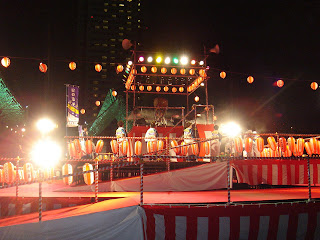お盆 (or just 盆 - ぼん - Bon) is a Buddhist festival that happens during the middle of Summer across the whole of Japan. Similar to Mexico's Day of the Dead, it's a time where people's ancestors are said to return to the world of the living. It's also one of the busiest times of year to travel, with thousands of travellers returning to their families for the occasion; if you wanted to experience being pushed on to a crowded train firsthand, お盆 would be a very good time for it.
So what is お盆 and what does it involve, exactly? Let's find out.
お盆 generally takes place on the 14th-16th of August every year, during the Summer holidays. The word "お盆" itself comes from a Sanskrit word that means "hanging upside down", which is considered a form of torture that departed souls need to be released from. In order to achieve this, people return to their hometowns to reunite with their families and honour their ancestors by cleaning their graves, giving offerings and receiving blessings from Buddhist priests. It's also a good time to reunite and catch up with the family, who in many cases will have drifted apart due to work and study commitments. I'm told that お盆 is exclusively a Buddhist event, unlike a lot of places and events in Japan that have become a blend of Buddhism and 神道 (しんとう - Shinto).
Cemeteries at this time become much more lively (if you'll forgive the pun), with families working together to maintain headstones, light incense, replace flowers and place food next to the graves. It's apparently quite uncommon for a family to make regular visits to graves and tombs under normal circumstances; instead, most traditional homes have what's known as a 仏壇 (ぶつだん - butsudan), a Buddhist household altar which can be prayed to in its stead. Families can book visits from a priest during お盆 to come and read mantras in front of the 仏壇, which must be quite long because it can take up to half an hour to finish one. Taken from Chinese, these are generally written almost entirely in 漢字 (かんじ - kanji), making them quite difficult to read. There are several mantras, but apparently most talk about how pleasant the "other world" is for the departed, filled with fields of flowers and kind guardians; this may be why お盆 didn't strike me as a particularly sad time.
Also associated with お盆 is the 盆踊り (ぼんおどり - bon odori - Bon Dance). A wooden stage is set up and strung with lanterns, then people dressed in 浴衣 (ゆかた - yukata - light cotton kimonos) lead the dance from on top. As a general rule, the various 盆踊り are held on the grounds of 神社 (じんじゃ - jinja - shrines) or in parks. They can be large-scale events in major public areas...
or small ones run by the local community.
In either case, the dance has lost a lot of its traditional religious meaning and I'm told it's mostly geared towards entertaining children now. I can definitely believe this - like most festivals, food and drink stalls are set up, but free snacks and juices were being offered for the local kids and several people were selling toys for them to play with while their parents danced. The dance itself is quite slow and measured to match the music, full of traditional instruments, drums and bells. At the bigger events there may be a singer to sing one of several famous 盆踊り songs live, but more often than not the dancers are just accompanied by a CD.
The specific steps of the dance depend on regional variation, but the basic steps are the same - slow steps forward and back, claps and waving hand motions. Some dances add their own flavour - a popular example is called the "Coal Miner's Dance" which adds steps that mimic working in an old mine such as digging and wheeling heavy loads around.As the crowd joins in and begins circling the stage, it starts to look a little bit like a square dance.
While お盆 might not be the most exciting festival on the Japanese calendar (and probably even less so for the people who have to travel in the meantime), I feel it's an important chance for everybody to take some time out of their busy schedules and get back to their roots. It's a familiar story, even among the families of my coworkers - children heading elsewhere to go to university or those with families of their own having to move to 東京 (とうきょう - Tokyo) for work - it's getting easier to drift apart. Work and study can wait; it's not every day you have a chance to have a proper family reunion, particularly one where everyone is invited!



No comments:
Post a Comment
If you have any questions or additions, I would love to hear from you. I may not know the answer, but I'll do my best to find out in any case! You can post anonymously if you like, but abusive/unintelligible/inappropriate comments will not be published.